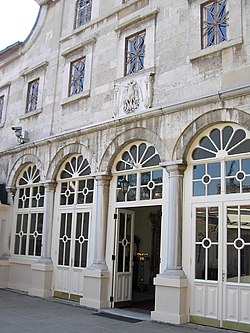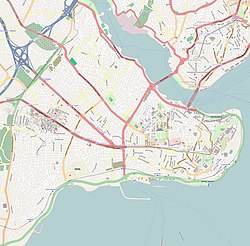This article includes a list of references, related reading, or external links, but its sources remain unclear because it lacks inline citations. (November 2022) |
| St. George's Church | |
|---|---|
| St. George's Patriarchal Temple | |
 | |
| 41°01′45″N 28°57′07″E / 41.02913°N 28.95187°E | |
| Location | Fener, Istanbul |
| Country | |
| Denomination | Eastern Orthodox Church |
| Tradition | Byzantine Rite |
| Website | www |
| History | |
| Dedication | Saint George |
| Architecture | |
| Designated | around 1600 |
| Style | Neoclassical Architecture |
| Clergy | |
| Archbishop | Bartholomew I of Constantinople |


The Patriarchal Cathedral Church of St. George (Greek: Πατριαρχικός Ναός του Αγίου Γεωργίου; Turkish: Aya Yorgi Kilisesi) is the principal Eastern Orthodox cathedral located in Istanbul, the largest city in Turkey and, as Constantinople, capital of the Byzantine Empire until 1453, and of the Ottoman Empire until 1922. Since about 1600,[1] it has been the seat of the Ecumenical Patriarchate of Constantinople whose leader is regarded as the primus inter pares (first among equals) in the Eastern Orthodox Church, and is frequently looked upon as the spiritual leader of the 300 million Orthodox Christians worldwide.[a]
The church, dedicated to the Christian martyr Saint George, is the site of numerous important services, and is where the patriarch will consecrate the chrism (myron) on Holy and Great Thursday, when needed. For this reason, the church is also known as the "Patriarchal Church of the Great Myrrh". At one time, the patriarch would consecrate all of the chrism used throughout the entire Orthodox Church.[20] However, now the heads of most of the autocephalous churches sanctify their own myrrh.
The church is located in the Fener (Phanar) district of Istanbul, northwest of the historic centre of old Constantinople. (Its address is Dr Sadık Ahmet Cadesi No 19, Fener 34083, Fatih-Istanbul.) It is a relatively small church, especially so considering its status in world Christianity. This, however, can be explained by the Islamic laws of the Ottoman Empire that governed the rights of dhimmis, which stipulate that all non-Islamic buildings must be smaller and humbler than corresponding Islamic buildings such as mosques: prior to the Ottoman conquest of Constantinople in 1453, the Patriarchal cathedral was Hagia Sophia (also known as the Cathedral of the Holy Wisdom).
The church is open to the public from 8.00 am to 4.30 pm, but strict security screening is in place. It is visited by a stream of pilgrims from Greece, other Orthodox countries and by tourists. Behind the church are the offices of the Patriarchate and the Patriarchate Library. The church, which was part of a convent or monastery before becoming the seat of the Patriarch, is outwardly modest, but its interior is lavishly decorated.
- ^ Various dates are given by different sources. The Ecumenical Patriarchate's website gives 1600.
- ^ Thomas E. Fitzgerald (1998). The Orthodox Church. Greenwood Publishing Group. p. 117. ISBN 978-0-275-96438-2.
THE VISIT OF THE ECUMENICAL PATRIARCH Ecumenical Patriarch Dimitrios I of Constantinople, together with a delegation that included five Metropolitans made an unprecedented visit to the United States 2–29 July 1990. Among the delegation was the present Patriarch, Patriarch Bartholomew, who succeeded Patriarch Dimitrios in 1991. Although other Orthodox Patriarchs had visited this country in the past, this was the first visit of the Ecumenical Patriarch. His visit had a special significance because he is viewed as the first bishop of the Orthodox Church. As such, non-Orthodox frequently consider the Ecumenical Patriarch to be the spiritual leader of the 300 million Orthodox Christians throughout the world, as do many of the Christians under his authority.
- ^ Andrew P. Holt; James Muldoon (2008). Competing Voices from the Crusades. Greenwood World Pub. p. xiv. ISBN 978-1-84645-011-2.
...one made during a visit to Greece in 2001 for the crusaders' sack of Constantinople in 1204. Three years later, Ecumenical Patriarch Bartholomew I, the spiritual leader of the world's 300 million Orthodox Christians, finally accepted the Pope's
- ^ Eastern Churches Journal: A Journal of Eastern Christendom. Society of Saint John Chrysostom. 2004. p. 181.
His All Holiness Ecumenical Patriarch Bartholomew is the 270th successor to the Apostle Andrew and spiritual leader of 300 million Orthodox Christians worldwide.
- ^ Dona J. Stewart (2013). The Middle East Today: Political, Geographical and Cultural Perspectives. Routledge. p. 71. ISBN 978-0-415-78243-2.
Bartholomew I, the Ecumenical Patriarch of Constantinople, spiritual leader of 300 million Orthodox Christians worldwide.
- ^ W. El-Ansary; D. Linnan (26 November 2010). Muslim and Christian Understanding: Theory and Application of "A Common Word". Springer. p. 82. ISBN 978-0-230-11440-1.
Ecumenical Patriarch Bartholomew is the 270th Archbishop to the 2,000-year-old Church of Constantinople (Istanbul), "first among equals" of Orthodox bishops worldwide, and spiritual leader to 300 million faithful.
- ^ Jewish Political Studies Review. Jerusalem Center for Public Affairs. 2001. p. 8.
Bartholomew I, the Ecumenical Patriarch of Constantinople, the spiritual leader of an estimated 300 million Orthodox Christians around the ..
- ^ Kathleen Dean Moore; Michael P. Nelson (15 April 2011). Moral Ground: Ethical Action for a Planet in Peril. Trinity University Press. p. 133. ISBN 978-1-59534-105-1.
Bartholomew I, the Ecumenical Patriarch of Constantinople, spiritual leader of 300 million Orthodox Christians worldwide.
- ^ The Living Church. The Living Church by Morehouse-Gorham Company. 1997. p. 3.
the Ecumenical Patriarch of Constantinople, Bartholomew I, is now touring 14 cities on his first visit to the United States. The 57-year-old leader of 300 million Orthodox Christians wore a gold and crimson mandya with train and tinkling bells
- ^ Katherine Marshall; Lucy Keough (2005). Finding Global Balance: Common Ground Between the Worlds of Development and Faith. World Bank Publications. p. 119. ISBN 978-0-8213-6247-1.
Bartholomew I, the Ecumenical Patriarch of Constantinople, spiritual leader of 300 million Orthodox Christians worldwide.
- ^ Libby Bassett; United Nations Environment Programme (2000). Earth and Faith: A Book of Reflection for Action. UNEP/Earthprint. p. 16. ISBN 978-92-807-1915-4.
Bartholomew I, the Ecumenical Patriarch of Constantinople, spiritual leader of 300 million Orthodox Christians worldwide.
- ^ Fairchild, Mary. "Christianity:Basics:Eastern Orthodox Church Denomination". about.com. Retrieved 22 May 2014.
- ^ Bron Taylor (10 June 2008). Encyclopedia of Religion and Nature. A&C Black. p. 158. ISBN 978-1-4411-2278-0.
The spiritual leader of the over 300 million Orthodox Christians worldwide, Ecumenical Patriarch Bartholomew – who has widely ...
- ^ "The Patriarch Bartholomew". 60 Minutes. CBS. 20 December 2009. Retrieved 11 January 2010.
- ^ "Quick facts about the Ecumenical Patriarch of Constantinople". Ecumenical Patriarch of Constantinople. Retrieved 18 June 2011.
His All Holiness Ecumenical Patriarch Bartholomew serves as the spiritual leader and representative worldwide voice of some 300 million Orthodox Christians throughout the world
- ^ "Biography – The Ecumenical Patriarchate". Patriarchate.org. Retrieved 2017-02-25.
- ^ "Pope Francis Bows, Asks for Blessing from Ecumenical Patriarch Bartholomew in Extraordinary Display of Christian Unity". www.huffingtonpost.com. Archived from the original on 1 December 2014. Retrieved 17 January 2022.
- ^ Finding Global Balance. World Bank Publications. p. 119. Retrieved 2 August 2015.
His All Holiness is the spiritual leader of 300 million Orthodox Christians worldwide
- ^ "Who is the Ecumenical Patriarch? – Apostolic Pilgrimage of Pope Francis and Ecumenical Patriarch Bartholomew to Jerusalem". Apostolicpilgrimage.org. Retrieved 2017-02-25.
- ^ Fortescue, Adrian (1909), "Eastern Churches", The Catholic Encyclopedia, vol. V, New York: Robert Appleton Company, retrieved 2008-03-09
Cite error: There are <ref group=lower-alpha> tags or {{efn}} templates on this page, but the references will not show without a {{reflist|group=lower-alpha}} template or {{notelist}} template (see the help page).
